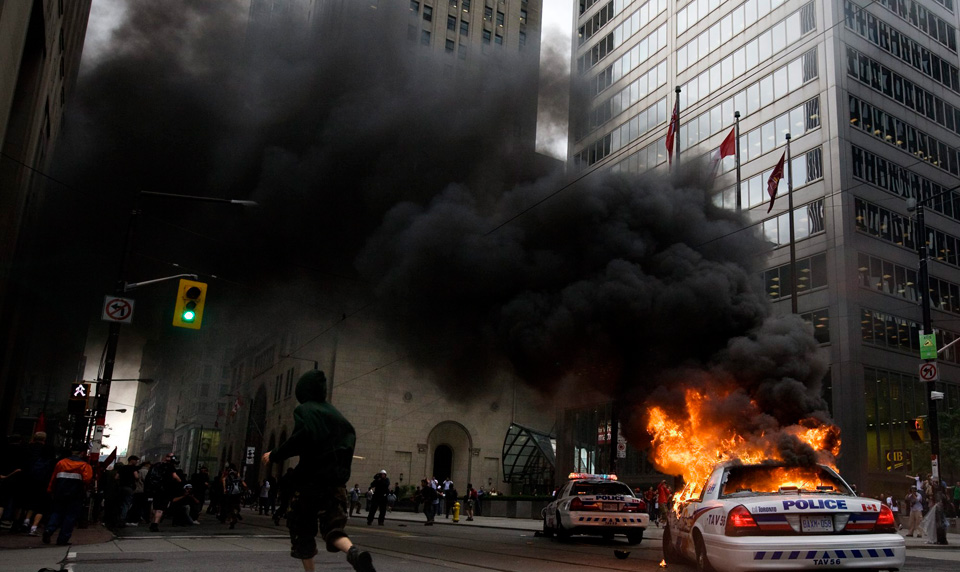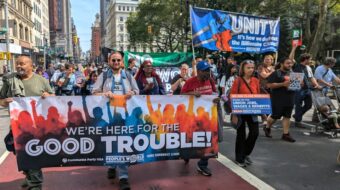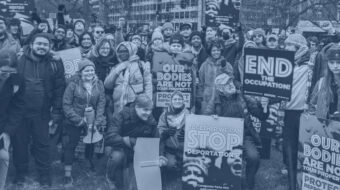
The far-right surge arising in the wake of the election of Donald Trump includes various shades of fascism. This is being abetted by the president and other major political leaders. It has led to a many-fronted crisis to which we need to prioritize effective resistance.
To be effective such resistance must do two things. First, it must aim to protect the sections of our society which are being targeted by the right-wing surge. African Americans, other minorities, immigrants, women, LGBTQ people, the poor, and the natural environment are all in the crosshairs of the right. Total solidarity of all with all is essential.
Second, effective resistance has to turn the politics of the situation around so that there is a truly massive, society-wide rejection of fascism and the right in the country, in the elections, in the legislative field, on the cultural front, and in every other possible arena. The 2017 and 2018 elections are thus tremendously important.
Right now, there is considerable discussion going on about the best way to do all these things. Tactics that make us feel good because they are exhilarating are not necessarily the same as effective tactics. They can, in fact, be precisely the opposite.
History teaches us is that the ruling class, the state and non-state institutions it controls, as well as the right have learned the political judo whereby the left’s actions may be turned around and used to strengthen the right and weaken the left.
Specifically, we should learn from the history of the agent provocateur, a specialist in manipulating conflict so as to benefit our enemies. Agents provocateurs are not merely enemy spies within the people’s movement. The provocateur has an even more sinister mission, which sometimes has deadly results.
What the provocateur frequently provokes is actions that either discredit the left or the people’s movement in the eyes of large numbers of people, or which entrap the unwary into acts that will allow police to pounce, accuse activists of plotting violent or other anti-social acts, and then lock them up.
Agents provocateurs have been known for well over a century, in many countries; the breed was especially rife in tsarist Russia in the late 1800s and early 1900s. In the United States, agents provocateurs often targeted labor union organizing efforts. Since the end of the Second World War and the beginning of the Cold War, there are many accounts of the FBI, other police bodies, the military, and private right-wing vigilante groups sending agents provocateurs into people’s organizations with the purpose of dividing, disrupting, and discrediting them and then laying them open to arrest and prosecution, or worse.
More radical than thou
In the 1960s and 1970s, there was a great outpouring of grassroots rejection of the policies, domestic and international, of the Cold War. The Civil Rights Movement, plus the movement against the Vietnam War, brought millions into the streets protesting courageously against the many injustices of our society.
The Cold Warriors and the ruling class did not like this, as they saw their interests threatened. So they developed open and covert strategies for undermining the new radicalism as well as the “old left” (communists and socialists). The idea was to make sure that the left did not continue to win over the support of the mass of the people of the United States to progressive and ultimately, revolutionary, socialist ideas.
The “new left” tendencies that arose at this time included many positive features but had some dangerous flaws also.
One flaw was that too often, a fetish was made of the absolute right of anybody involved in an organization to express his or her opinion no matter how divergent from the main goals of the organization, or to engage in any activity which was “radical” regardless of whether it helped or harmed the cause. This extreme liberalism laid many organizations open to manipulation of some of their weakest elements by agents provocateurs.
There was also a tendency to compete to see who was most radical. The competition for revolutionary “cred” was a godsend for agents provocateurs, who actively encouraged such competition. The lack of connections, especially among campus-based white radicals, to the working class and its politics exacerbated this trend by eliminating an important reality check.
Picking off leaders and undermining public support
There also tended to be a cult of leadership within many radical organizations which put their leaders into a vulnerable position in which they could be targeted for neutralization so as to undermine the whole movement. J. Edgar Hoover’s FBI, for instance, put a huge amount of effort into neutralizing leaders.
The agents provocateurs were deployed in such a way as to discredit the leaders and their organizations, to create splits in the movement, and in some cases to provoke violence which would lead to physical elimination of leaders plus a societal repudiation of the movement.
The 1960s campus-based movement against the Vietnam War was a top target for agents provocateurs. There were several at work, but one, known as “Tommy the Traveler” was particularly memorable. He, too, concentrated on enticing impressionable young would-be “revolutionaries” to commit acts that would divide the movement while landing them in jail.
Hoover, a crusading anti-communist and paranoid racist, paid particular attention to disrupting the highly-effective African American people’s movement, often employing agents provocateurs to create friction within and between liberation organizations. This led to several murders.
In 1967, for example, agents provocateurs, especially a certain William O’Neal, described in a Nation article as “infatuated with weapons,” played a role in the police murder of Illinois Black Panther Party leaders Fred Hampton and Mark Clark. Hampton had been suspicious of O’Neal because of his violent talk, but others did not see through him, with tragic results. O’Neal’s promotion of crackpot violent schemes should have been a giveaway. When O’Neal set up Hampton and Clark for a brutal murder by police acting under the orders of Cook County State’s Attorney Ed Hanrahan, the perpetrators were able to convince sectors of the public that the Panthers were prone to violence and shot first, which was untrue.
Another example was the crime of Cerro Maravilla, in Puerto Rico, on July 25, 1978.
An agent provocateur, Alejandro González Malavé, working undercover for the Puerto Rican police, enticed two idealistic young supporters of independence for Puerto Rico into a reckless act that cost them their lives. One was Carlos Enrique Soto Areví, the son of one of Puerto Rico’s most important literary figures, the novelist Pedro Juan Soto. The second was a self-taught worker, Arnaldo Dario Rosado. Both were on fire with indignation at the colonialist treatment that Puerto Rico received at the hands of the United States (treatment which continues today). They wanted to demonstrate this indignation in some dramatic way.
Their lack of practical political experience made them easy prey for González Malavé. He persuaded them that a noble act for their homeland would be to destroy some communications towers on the top of a hill called “Cerro Maravilla.” This was supposed to express solidarity with some imprisoned Puerto Rican independence fighters.
The three kidnapped a taxi driver and forced him to drive them up to Cerro Maravilla. But when they arrived, they found they had been led into a police ambush. As the armed police approached, González Malavé identified himself as an agent, but Soto and Rosado were killed, and the “official” story was put out that they had been shot in a firefight with the cops.
The right-wing, pro-statehood governor at the time, Carlos Romero Barceló, hailed the police as heroes, and the FBI helpfully pitched in to support the Puerto Rican Justice Department with the cover-up.
However, the police had left a “loose end,” namely the taxi driver, who spoke to the press and revealed that in fact González Malavé was a police agent and that the two young men were still alive when he left the place. The police had entrapped the two men, then murdered them after they surrendered.
This became a big scandal, and eventually led to prosecutions and the defeat of Romero Barceló’s party in the next elections. But the use of agents provocateurs to divide and isolate the Puerto Rican left has been unrelenting, both before and after that incident.
Disrupting today’s movements
Such agent provocateur tactics surfaced again during the protests against the Iraq War, and in the “Occupy” movement. In each case, glib charismatic strangers wormed their way into protest organizations, and then entrapped inexperienced young radicals to get involved in plans, which were sometimes really just talk, to engage in violence. A typical case is that of the “Cleveland bomb plot” of 2012. Another is the San Francisco Mission District riot of May 2012, when a mysterious black-clad contingent hijacked part of a peaceful “Occupy” demonstration and turned it toward random violence. In both cases, the purpose of the provocateurs was to discredit the movement in the eyes of the public, which otherwise might have been receptive to Occupy’s “99 percent versus one percent” message.
This kind of manipulation still continues by all accounts. As before, the purpose is to discredit the movement, divide it, deprive it of allies, and set up leaders and organizations for repressive action while making sure that this repression will not produce a wave of public indignation, as happened with the Cerro Maravilla case.
The right and the ruling class always try to portray these people’s movements as violent, because this is the alchemy best suited to turn public opinion against them. This is the main lesson to be learned from the agent provocateur experiences of the past.
In the conditions of our country today, injecting violent tactics into the mass movement of protest undermines that movement and plays the enemy’s game.
Loose talk about violence can be just as dangerous. This danger is multiplied by the development of online communications and social media—there are no secrets now.
Hijacking other people’s protest actions to “move them to a higher level,” meaning toward violent confrontations, is really a dirty kind of pseudo-left politics.
What is needed now is to build the movement into a great wave of rejection against the reactionary policies of the ruling class, the right, and the Trump administration and its allies. Let us work on that basis and avoid tactics that undermine it.










